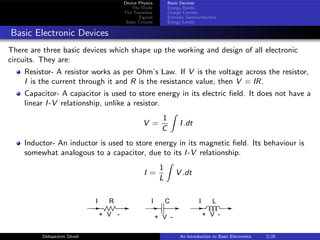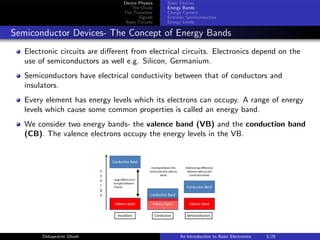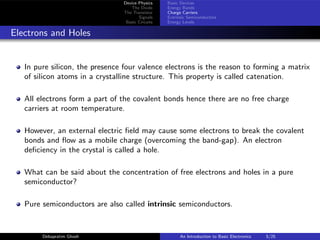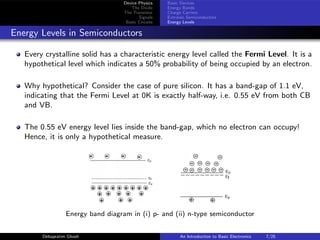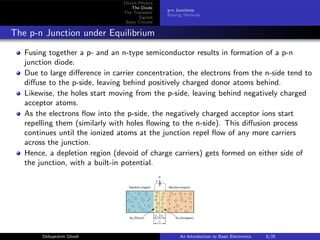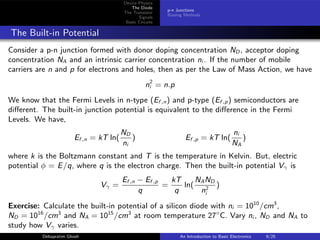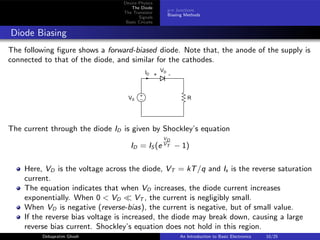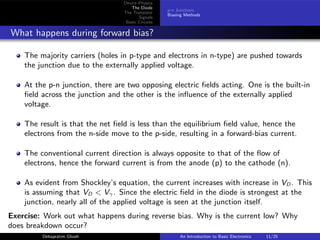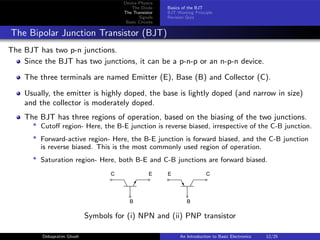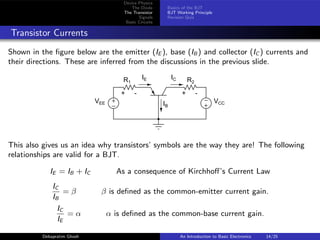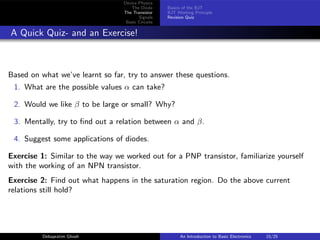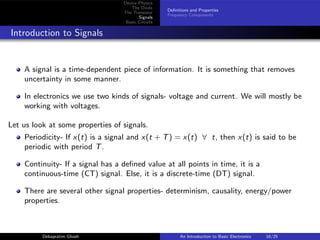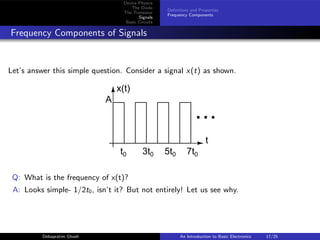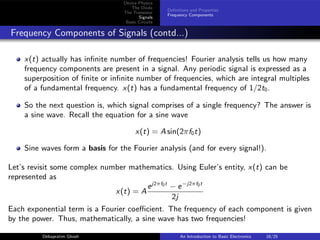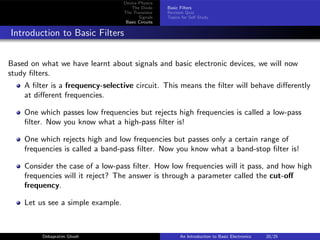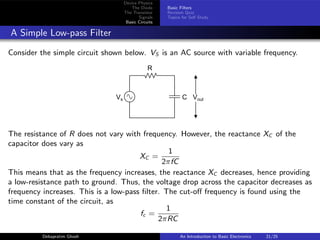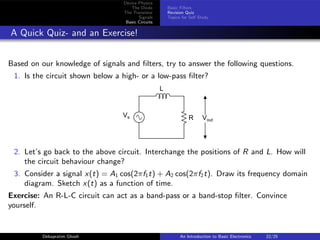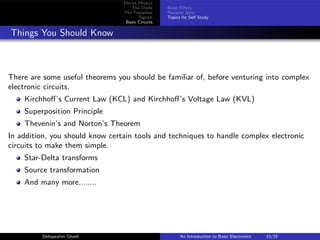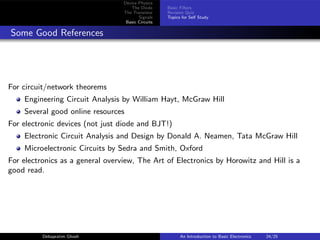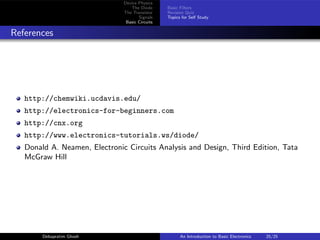Basic Electronics Presentation Guide Engineer
- 1. Device Physics The Diode The Transistor Signals Basic Circuits An Introduction to Basic Electronics Debapratim Ghosh deba21pratim@gmail.com Electronic Systems Group Department of Electrical Engineering IIT Bombay Debapratim Ghosh An Introduction to Basic Electronics 1/25
- 2. Device Physics The Diode The Transistor Signals Basic Circuits Basic Devices Energy Bands Charge Carriers Extrinsic Semiconductors Energy Levels Basic Electronic Devices There are three basic devices which shape up the working and design of all electronic circuits. They are: Resistor- A resistor works as per OhmŌĆÖs Law. If V is the voltage across the resistor, I is the current through it and R is the resistance value, then V = IR. Capacitor- A capacitor is used to store energy in its electric field. It does not have a linear I-V relationship, unlike a resistor. V = 1 C Z I.dt Inductor- An inductor is used to store energy in its magnetic field. Its behaviour is somewhat analogous to a capacitor, due to its I-V relationship. I = 1 L Z V .dt + - V R I I C + - V I + - V L Debapratim Ghosh An Introduction to Basic Electronics 2/25
- 3. Device Physics The Diode The Transistor Signals Basic Circuits Basic Devices Energy Bands Charge Carriers Extrinsic Semiconductors Energy Levels Semiconductor Devices- The Concept of Energy Bands Electronic circuits are different from electrical circuits. Electronics depend on the use of semiconductors as well e.g. Silicon, Germanium. Semiconductors have electrical conductivity between that of conductors and insulators. Every element has energy levels which its electrons can occupy. A range of energy levels which cause some common properties is called an energy band. We consider two energy bands- the valence band (VB) and the conduction band (CB). The valence electrons occupy the energy levels in the VB. Debapratim Ghosh An Introduction to Basic Electronics 3/25
- 4. Device Physics The Diode The Transistor Signals Basic Circuits Basic Devices Energy Bands Charge Carriers Extrinsic Semiconductors Energy Levels The Concept of Energy Bands (contd...) What does this imply? From the band structure figure, it is clear that even at room temperature, metals have free electrons in the conduction band, which make them good conductors. The difference between the lowest energy level in the CB and the highest energy level in the VB is called a band-gap. Larger the band-gap, lesser is the conductivity. Semiconductors are insulators at room temperature. However, with an externally applied voltage, the valence electrons in the semiconductor may overcome the band-gap and climb to the CB. The band-gap is about 1.1 eV for silicon. Debapratim Ghosh An Introduction to Basic Electronics 4/25
- 5. Device Physics The Diode The Transistor Signals Basic Circuits Basic Devices Energy Bands Charge Carriers Extrinsic Semiconductors Energy Levels Electrons and Holes In pure silicon, the presence four valence electrons is the reason to forming a matrix of silicon atoms in a crystalline structure. This property is called catenation. All electrons form a part of the covalent bonds hence there are no free charge carriers at room temperature. However, an external electric field may cause some electrons to break the covalent bonds and flow as a mobile charge (overcoming the band-gap). An electron deficiency in the crystal is called a hole. What can be said about the concentration of free electrons and holes in a pure semiconductor? Pure semiconductors are also called intrinsic semiconductors. Debapratim Ghosh An Introduction to Basic Electronics 5/25
- 6. Device Physics The Diode The Transistor Signals Basic Circuits Basic Devices Energy Bands Charge Carriers Extrinsic Semiconductors Energy Levels Increasing the Carrier Concentration To increase free electrons at room temperature, impurities can be introduced into the crystal. By diffusing pentavalent element atoms (e.g. phosphorous, arsenic), excess free electrons are created. Such kind of semiconductors are called extrinsic semiconductors. This process is called doping. Pentavalent dopants introduce donor atoms in the crystal. Since electrons form the majority of carriers, this material is called an n-type semiconductor. Can you guess what kind of elements need to be doped into silicon to form a p-type semiconductor? What will be the majority carriers here? Debapratim Ghosh An Introduction to Basic Electronics 6/25
- 7. Device Physics The Diode The Transistor Signals Basic Circuits Basic Devices Energy Bands Charge Carriers Extrinsic Semiconductors Energy Levels Energy Levels in Semiconductors Every crystalline solid has a characteristic energy level called the Fermi Level. It is a hypothetical level which indicates a 50% probability of being occupied by an electron. Why hypothetical? Consider the case of pure silicon. It has a band-gap of 1.1 eV, indicating that the Fermi Level at 0K is exactly half-way, i.e. 0.55 eV from both CB and VB. The 0.55 eV energy level lies inside the band-gap, which no electron can occupy! Hence, it is only a hypothetical measure. Energy band diagram in (i) p- and (ii) n-type semiconductor Debapratim Ghosh An Introduction to Basic Electronics 7/25
- 8. Device Physics The Diode The Transistor Signals Basic Circuits p-n Junctions Biasing Methods The p-n Junction under Equilibrium Fusing together a p- and an n-type semiconductor results in formation of a p-n junction diode. Due to large difference in carrier concentration, the electrons from the n-side tend to diffuse to the p-side, leaving behind positively charged donor atoms behind. Likewise, the holes start moving from the p-side, leaving behind negatively charged acceptor atoms. As the electrons flow into the p-side, the negatively charged acceptor ions start repelling them (similarly with holes flowing to the n-side). This diffusion process continues until the ionized atoms at the junction repel flow of any more carriers across the junction. Hence, a depletion region (devoid of charge carriers) gets formed on either side of the junction, with a built-in potential. Debapratim Ghosh An Introduction to Basic Electronics 8/25
- 9. Device Physics The Diode The Transistor Signals Basic Circuits p-n Junctions Biasing Methods The Built-in Potential Consider a p-n junction formed with donor doping concentration ND , acceptor doping concentration NA and an intrinsic carrier concentration ni . If the number of mobile carriers are n and p for electrons and holes, then as per the Law of Mass Action, we have n2 i = n.p We know that the Fermi Levels in n-type (Ef ,n) and p-type (Ef ,p) semiconductors are different. The built-in junction potential is equivalent to the difference in the Fermi Levels. We have, Ef ,n = kT ln( ND ni ) Ef ,p = kT ln( ni NA ) where k is the Boltzmann constant and T is the temperature in Kelvin. But, electric potential Žå = E/q, where q is the electron charge. Then the built-in potential V╬│ is V╬│ = Ef ,n ŌłÆ Ef ,p q = kT q ln( NAND n2 i ) Exercise: Calculate the built-in potential of a silicon diode with ni = 1010 /cm3 , ND = 1016 /cm3 and NA = 1015 /cm3 at room temperature 27ŌŚ” C. Vary ni , ND and NA to study how V╬│ varies. Debapratim Ghosh An Introduction to Basic Electronics 9/25
- 10. Device Physics The Diode The Transistor Signals Basic Circuits p-n Junctions Biasing Methods Diode Biasing The following figure shows a forward-biased diode. Note that, the anode of the supply is connected to that of the diode, and similar for the cathodes. + ŌłÆ R + - VD ID VS The current through the diode ID is given by ShockleyŌĆÖs equation ID = IS (e VD VT ŌłÆ 1) Here, VD is the voltage across the diode, VT = kT/q and Is is the reverse saturation current. The equation indicates that when VD increases, the diode current increases exponentially. When 0 < VD Ōē¬ VT , the current is negligibly small. When VD is negative (reverse-bias), the current is negative, but of small value. If the reverse bias voltage is increased, the diode may break down, causing a large reverse bias current. ShockleyŌĆÖs equation does not hold in this region. Debapratim Ghosh An Introduction to Basic Electronics 10/25
- 11. Device Physics The Diode The Transistor Signals Basic Circuits p-n Junctions Biasing Methods What happens during forward bias? The majority carriers (holes in p-type and electrons in n-type) are pushed towards the junction due to the externally applied voltage. At the p-n junction, there are two opposing electric fields acting. One is the built-in field across the junction and the other is the influence of the externally applied voltage. The result is that the net field is less than the equilibrium field value, hence the electrons from the n-side move to the p-side, resulting in a forward-bias current. The conventional current direction is always opposite to that of the flow of electrons, hence the forward current is from the anode (p) to the cathode (n). As evident from ShockleyŌĆÖs equation, the current increases with increase in VD . This is assuming that VD < V╬│. Since the electric field in the diode is strongest at the junction, nearly all of the applied voltage is seen at the junction itself. Exercise: Work out what happens during reverse bias. Why is the current low? Why does breakdown occur? Debapratim Ghosh An Introduction to Basic Electronics 11/25
- 12. Device Physics The Diode The Transistor Signals Basic Circuits Basics of the BJT BJT Working Principle Revision Quiz The Bipolar Junction Transistor (BJT) The BJT has two p-n junctions. Since the BJT has two junctions, it can be a p-n-p or an n-p-n device. The three terminals are named Emitter (E), Base (B) and Collector (C). Usually, the emitter is highly doped, the base is lightly doped (and narrow in size) and the collector is moderately doped. The BJT has three regions of operation, based on the biasing of the two junctions. * Cutoff region- Here, the B-E junction is reverse biased, irrespective of the C-B junction. * Forward-active region- Here, the B-E junction is forward biased, and the C-B junction is reverse biased. This is the most commonly used region of operation. * Saturation region- Here, both B-E and C-B junctions are forward biased. C E E C B B Symbols for (i) NPN and (ii) PNP transistor Debapratim Ghosh An Introduction to Basic Electronics 12/25
- 13. Device Physics The Diode The Transistor Signals Basic Circuits Basics of the BJT BJT Working Principle Revision Quiz Example- Working of a PNP transistor Consider the figure shown below. The transistor is in forward-active region. + ŌłÆ + ŌłÆ R1 R2 VEE VCC As the B-E junction is forward biased, holes move across to the base (emitter current). Since the base is narrow and lightly doped, the minority electron-hole recombinations are less. Due to the large carrier concentration gradient in the B-E region, majority of the holes diffuse across the base into the C-B junction. Since the C-B junction is reverse biased, the junction electric field sweeps out the holes into the collector (collector current). A small minority of electrons flow from the base to the emitter. Also, a small number of holes coming from the emitter recombine with electrons in the base. New electrons from the supply flow into the base to replace the the lost electrons. These two components form the base current. Debapratim Ghosh An Introduction to Basic Electronics 13/25
- 14. Device Physics The Diode The Transistor Signals Basic Circuits Basics of the BJT BJT Working Principle Revision Quiz Transistor Currents Shown in the figure below are the emitter (IE ), base (IB ) and collector (IC ) currents and their directions. These are inferred from the discussions in the previous slide. + ŌłÆ + ŌłÆ + - + - VEE VCC R1 R2 IE IB IC This also gives us an idea why transistorsŌĆÖ symbols are the way they are! The following relationships are valid for a BJT. IE = IB + IC As a consequence of KirchhoffŌĆÖs Current Law IC IB = ╬▓ ╬▓ is defined as the common-emitter current gain. IC IE = ╬▒ ╬▒ is defined as the common-base current gain. Debapratim Ghosh An Introduction to Basic Electronics 14/25
- 15. Device Physics The Diode The Transistor Signals Basic Circuits Basics of the BJT BJT Working Principle Revision Quiz A Quick Quiz- and an Exercise! Based on what weŌĆÖve learnt so far, try to answer these questions. 1. What are the possible values ╬▒ can take? 2. Would we like ╬▓ to be large or small? Why? 3. Mentally, try to find out a relation between ╬▒ and ╬▓. 4. Suggest some applications of diodes. Exercise 1: Similar to the way we worked out for a PNP transistor, familiarize yourself with the working of an NPN transistor. Exercise 2: Find out what happens in the saturation region. Do the above current relations still hold? Debapratim Ghosh An Introduction to Basic Electronics 15/25
- 16. Device Physics The Diode The Transistor Signals Basic Circuits Definitions and Properties Frequency Components Introduction to Signals A signal is a time-dependent piece of information. It is something that removes uncertainty in some manner. In electronics we use two kinds of signals- voltage and current. We will mostly be working with voltages. Let us look at some properties of signals. Periodicity- If x(t) is a signal and x(t + T) = x(t) ŌłĆ t, then x(t) is said to be periodic with period T. Continuity- If a signal has a defined value at all points in time, it is a continuous-time (CT) signal. Else, it is a discrete-time (DT) signal. There are several other signal properties- determinism, causality, energy/power properties. Debapratim Ghosh An Introduction to Basic Electronics 16/25
- 17. Device Physics The Diode The Transistor Signals Basic Circuits Definitions and Properties Frequency Components Frequency Components of Signals LetŌĆÖs answer this simple question. Consider a signal x(t) as shown. t x(t) A t0 3t0 5t0 7t0 Q: What is the frequency of x(t)? Debapratim Ghosh An Introduction to Basic Electronics 17/25
- 18. Device Physics The Diode The Transistor Signals Basic Circuits Definitions and Properties Frequency Components Frequency Components of Signals LetŌĆÖs answer this simple question. Consider a signal x(t) as shown. t x(t) A t0 3t0 5t0 7t0 Q: What is the frequency of x(t)? A: Looks simple- 1/2t0, isnŌĆÖt it? But not entirely! Let us see why. Debapratim Ghosh An Introduction to Basic Electronics 17/25
- 19. Device Physics The Diode The Transistor Signals Basic Circuits Definitions and Properties Frequency Components Frequency Components of Signals (contd...) x(t) actually has infinite number of frequencies! Fourier analysis tells us how many frequency components are present in a signal. Any periodic signal is expressed as a superposition of finite or infinite number of frequencies, which are integral multiples of a fundamental frequency. x(t) has a fundamental frequency of 1/2t0. So the next question is, which signal comprises of a single frequency? The answer is a sine wave. Recall the equation for a sine wave x(t) = A sin(2ŽĆf0t) Sine waves form a basis for the Fourier analysis (and for every signal!). LetŌĆÖs revisit some complex number mathematics. Using EulerŌĆÖs entity, x(t) can be represented as x(t) = A ej2ŽĆf0t ŌłÆ eŌłÆj2ŽĆf0t 2j Each exponential term is a Fourier coefficient. The frequency of each component is given by the power. Thus, mathematically, a sine wave has two frequencies! Debapratim Ghosh An Introduction to Basic Electronics 18/25
- 20. Device Physics The Diode The Transistor Signals Basic Circuits Definitions and Properties Frequency Components Frequency Components of Signals (contd...) Magnitude f 0 f0 -f0 A/2 -A/2 Debapratim Ghosh An Introduction to Basic Electronics 19/25
- 21. Device Physics The Diode The Transistor Signals Basic Circuits Basic Filters Revision Quiz Topics for Self Study Introduction to Basic Filters Based on what we have learnt about signals and basic electronic devices, we will now study filters. A filter is a frequency-selective circuit. This means the filter will behave differently at different frequencies. One which passes low frequencies but rejects high frequencies is called a low-pass filter. Now you know what a high-pass filter is! One which rejects high and low frequencies but passes only a certain range of frequencies is called a band-pass filter. Now you know what a band-stop filter is! Consider the case of a low-pass filter. How low frequencies will it pass, and how high frequencies will it reject? The answer is through a parameter called the cut-off frequency. Let us see a simple example. Debapratim Ghosh An Introduction to Basic Electronics 20/25
- 22. Device Physics The Diode The Transistor Signals Basic Circuits Basic Filters Revision Quiz Topics for Self Study A Simple Low-pass Filter Consider the simple circuit shown below. VS is an AC source with variable frequency. R C Vs Vout The resistance of R does not vary with frequency. However, the reactance XC of the capacitor does vary as XC = 1 2ŽĆfC This means that as the frequency increases, the reactance XC decreases, hence providing a low-resistance path to ground. Thus, the voltage drop across the capacitor decreases as frequency increases. This is a low-pass filter. The cut-off frequency is found using the time constant of the circuit, as fc = 1 2ŽĆRC Debapratim Ghosh An Introduction to Basic Electronics 21/25
- 23. Device Physics The Diode The Transistor Signals Basic Circuits Basic Filters Revision Quiz Topics for Self Study A Quick Quiz- and an Exercise! Based on our knowledge of signals and filters, try to answer the following questions. 1. Is the circuit shown below a high- or a low-pass filter? L R Vout Vs 2. LetŌĆÖs go back to the above circuit. Interchange the positions of R and L. How will the circuit behaviour change? 3. Consider a signal x(t) = A1 cos(2ŽĆf1t) + A2 cos(2ŽĆf2t). Draw its frequency domain diagram. Sketch x(t) as a function of time. Exercise: An R-L-C circuit can act as a band-pass or a band-stop filter. Convince yourself. Debapratim Ghosh An Introduction to Basic Electronics 22/25
- 24. Device Physics The Diode The Transistor Signals Basic Circuits Basic Filters Revision Quiz Topics for Self Study Things You Should Know There are some useful theorems you should be familiar of, before venturing into complex electronic circuits. KirchhoffŌĆÖs Current Law (KCL) and KirchhoffŌĆÖs Voltage Law (KVL) Superposition Principle TheveninŌĆÖs and NortonŌĆÖs Theorem In addition, you should know certain tools and techniques to handle complex electronic circuits to make them simple. Star-Delta transforms Source transformation And many more........ Debapratim Ghosh An Introduction to Basic Electronics 23/25
- 25. Device Physics The Diode The Transistor Signals Basic Circuits Basic Filters Revision Quiz Topics for Self Study Some Good References For circuit/network theorems Engineering Circuit Analysis by William Hayt, McGraw Hill Several good online resources For electronic devices (not just diode and BJT!) Electronic Circuit Analysis and Design by Donald A. Neamen, Tata McGraw Hill Microelectronic Circuits by Sedra and Smith, Oxford For electronics as a general overview, The Art of Electronics by Horowitz and Hill is a good read. Debapratim Ghosh An Introduction to Basic Electronics 24/25
- 26. Device Physics The Diode The Transistor Signals Basic Circuits Basic Filters Revision Quiz Topics for Self Study References http://chemwiki.ucdavis.edu/ http://electronics-for-beginners.com http://cnx.org http://www.electronics-tutorials.ws/diode/ Donald A. Neamen, Electronic Circuits Analysis and Design, Third Edition, Tata McGraw Hill Debapratim Ghosh An Introduction to Basic Electronics 25/25

